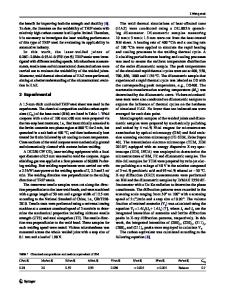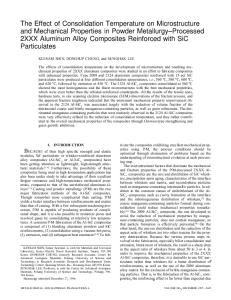Effect of Peak Temperature on Microstructure and Mechanical Properties of Thermally Simulated Welding Heat-Affected Zone
- PDF / 4,085,475 Bytes
- 10 Pages / 593.972 x 792 pts Page_size
- 30 Downloads / 288 Views
ÓASM International 1059-9495/$19.00
Effect of Peak Temperature on Microstructure and Mechanical Properties of Thermally Simulated Welding Heat-Affected Zones for 09MnNiDR Steel Rui Cao, Zhaoqing Yang, Jinmei Li, Xiaowu Liang, Wanqing Lei, Jianxiao Zhang, and Jianhong Chen (Submitted February 20, 2020; in revised form September 5, 2020; Accepted September 7, 2020) The microstructures and mechanical properties of various heat-affected zones (HAZs) for 09MnNiDR pressure vessel steel are systematically analyzed. The results show that at 2 70 °C, the thermally simulated subcritical heat-affected zone (SCHAZ) reaches the impact toughness of 270 J, which is the highest among various HAZs. Owing to the appearance of martensite–austenite (M–A) constituents distributed along the grain boundary in the thermally simulated critical heat-affected zone and fine-grained heat-affected zone, the impact toughness sharply decreases compared with that of the SCHAZ. The impact toughness of the coarse-grained heat-affected zone (CGHAZ) reaches 20 J, which makes the CGHAZ the weakest zone. The microstructure of the CGHAZ is composed of relatively coarse bainite and ferrite. Moreover, the proportion of high-angle grain boundaries (HAGBs) in CGHAZ is the lowest, at only 22%. Coarse grain size, microstructural transformation, and different proportions of HAGBs significantly affect the impact toughness in each zone of HAZs. Keywords
09MnNiDR, high-angle grain boundary, impact toughness, martensite–austenite constituent, weakest zone
1. Introduction Low-temperature pressure vessel 09MnNiDR steel at 70 °C has been widely used in low-temperature devices such as ethylene, fertilizer, city gas, and carbon dioxide. Owing to its low-temperature toughness, it has a wide market demand. However, the properties of welded joints have been one of the difficulties associated with the pressure vessel manufacturing process. The coarse-grained heat-affected zone (CGHAZ) of the welding heat-affected zones (HAZs) is more likely to produce coarse grains and microstructures that deteriorate lowtemperature toughness, such as granular bainite (GB) and coarse martensite–austenite (M–A) constituents. Therefore, the comprehensive mechanical properties and weldability of steels need to be gradually improved (Ref 1). A number of studies have investigated the properties of the weld metal (WM) and HAZs to determine the weakest zone and determine the reason for the fracture failure in various Rui Cao, Zhaoqing Yang, and Jianhong Chen, State Key Laboratory of Advanced Processing and Recycling of Non-ferrous Metal, Department of Materials Science and Engineering, Lanzhou University of Technology, Lanzhou 730050, PeopleÕs Republic of China; and School of Materials Science and Engineering, Lanzhou University of Technology, Lanzhou 730050 Gansu, PeopleÕs Republic of China; Jinmei Li and Wanqing Lei, Lanzhou Ls Testing Technology Co. Ltd, Lanzhou 730050, PeopleÕs Republic of China; Xiaowu Liang and Jianxiao Zhang, Lanzhou Ls Heavy Equipment Co. Ltd, Lanzhou 730050, PeopleÕs Repu
Data Loading...











